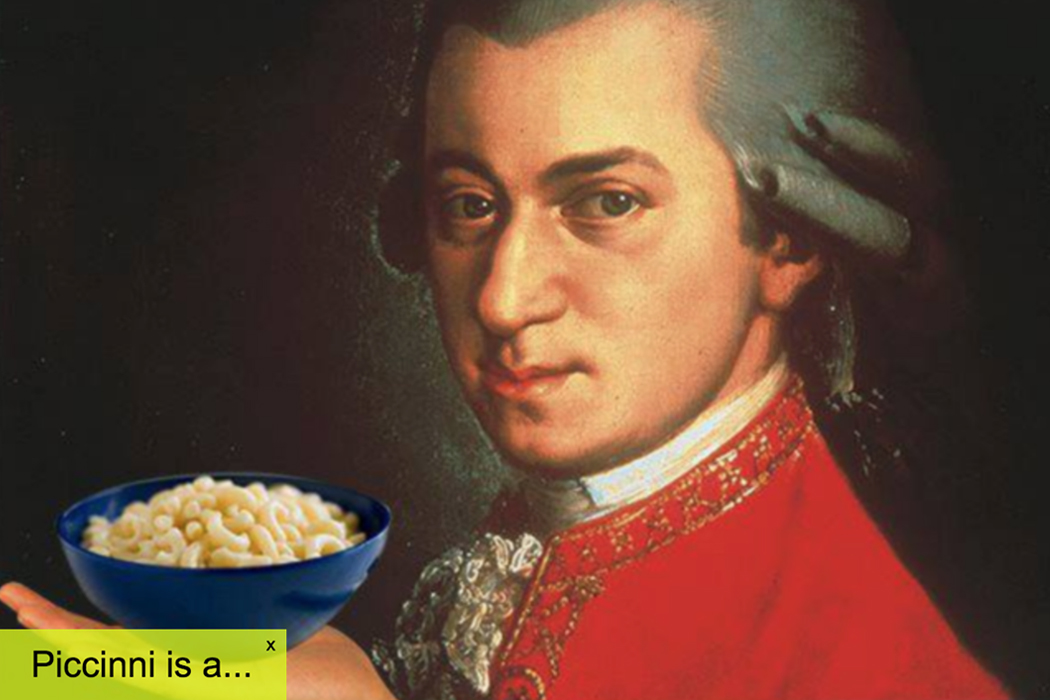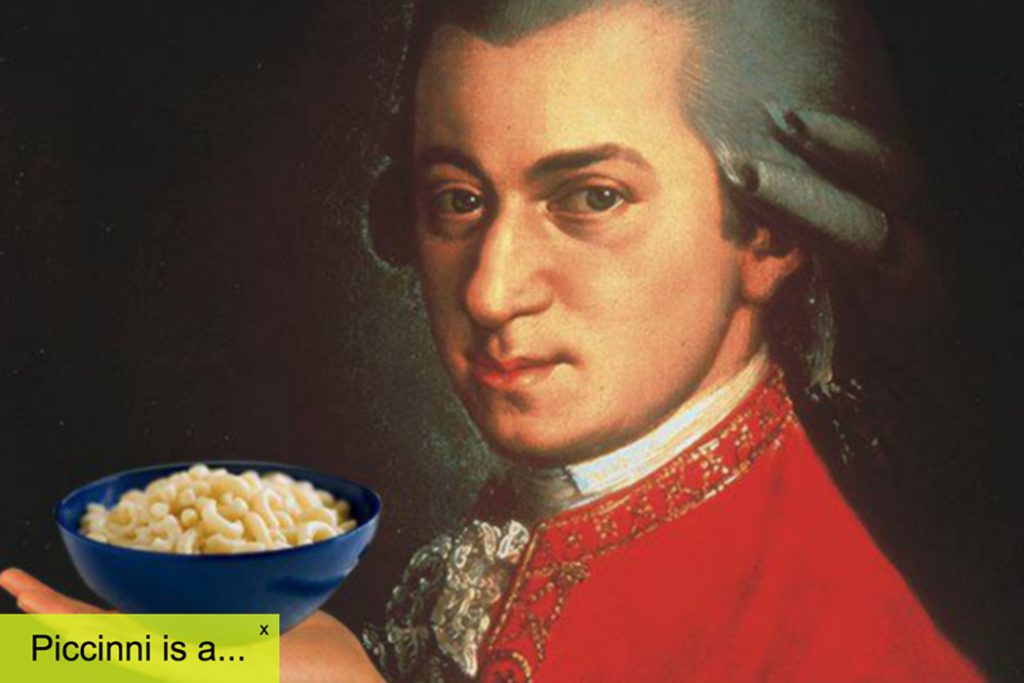
+ Welcome to Soundfly! We help curious musicians meet their goals with creative online courses. Whatever you want to learn, whenever you need to learn it. Subscribe now to start learning on the ’Fly.
In case you haven’t seen this, or tried it yet, Classic FM (the website version) has created one of the most entertaining and informative tiny “time-waster” games on the internet that we’ve found so far. It’s called “Are These Words Composers or Types of Pasta” and it’s 15 questions of mouth-watering musical joy where you have to try to guess which is which. I’ve played this game thrice and somehow never gotten a perfect score.
But that’s because so many of the composers listed are relatively obscure Italian artists we don’t tend to talk about much. Composers who have created extraordinarily beautiful music and contributed positively to Italy’s vast and vibrant history, yet are more or less forgotten today. So, since it’s Friday, we thought it would be fun to explore a bit about each of the composers we’ve been introduced to via this game.
Spoiler Alert! If you haven’t played yet, head over there now via this link and try your hand at the game. The rest of this article will feature spoilers, and information only about the composers (not the pasta… that will only appear when we eventually launch our food blog, Flambé-per, or Floundersy — name TBD). Turn back now and don’t say we didn’t warn you.
Okay let’s learn about some new composers, shall we?!
Ildebrando Pizzetti
Right off the bat, I think I’ve found one of my new favorite composers ever. His music is simply stunning. Ildebrando Pizzetti was born in Parma in 1880 to the pianist, Odoardo Pizzetti. His father taught him to play piano at a young age; but Ildebrando’s first love was writing plays — he had two produced for the stage before he turned 15. His focus turned back to music and he decided to enter the Musical Conservatorium of Parma in 1895 to study music full-time with Giovanni Tebaldini.
Pizzetti went on to write all kinds of music, including music for the theater (which he continued to adore), and eventually became a teacher at the Conservatory in Florence. He would go on to become director there from 1917 to 1923, before moving on to direct the Milan Conservatory, and ultimately succeeding Ottorino Respighi as the director of the Academy of St. Cecilia in Rome from 1936 to 1958. Pizzetti’s oeuvre includes orchestral symphonies and concertos, operas, church music, chamber music, and one single film score for the 1941 film, I Promessi Sposi.
Pizzetti wrote several books, mostly of musical criticism (he co-founded a journal of modern music, Dissonanza in 1914), but notably also a biography of Niccolò Paganini. His music is lush, diverse in terms of what he asks of his orchestral players, and sincere. It fits well with the times, being not all that dissimilar to the beauty and drama of Claude Debussy and Vaughan Williams; and it yet fits even more perfectly into the history of Italian sacred music and operatic canon. A true delight to discover him here.
Maria Teresa Agnesi Pinottini
A woman composer of the 18th century? Blasphemy! Maria Teresa Agnesi was born in Milan in 1720 to Pietro Agnesi, a man of modest nobility. She received a wonderful liberal arts education with her sister, who became a lecturing mathematician, while Maria Teresa turned out to be a talented harpsichordist and singer.
Not much is known about Agnesi’s life after she married Pier Antonio Pinottini and took his name, and much of her music is either lost or undated. However, we do know that she received generous compositional patronage from Holy Roman Empress, Maria Theresia Walburga Amalia Christina, and another female noble composer, Maria Antonia Walpurgis. The Holy Roman Empress apparently sung Agnesi Pinottini’s music publicly. There is a story that Agnes Pinottini was part of an organizational committee that invited the 14-year old Mozart to play in Milan in 1770 and present at his performance. She composed some operas, as well as quite a bit of keyboard and vocal music for small chamber ensembles.
Domenico Dragonetti
Domenico Dragonetti’s three-string double bass, on which he was considered Europe’s greatest virtuoso, hangs today at the Victoria and Albert Museum in London. He was born in Venice in 1763, and took up music at a young age. His talent was picked up on immediately, and at 13 years old, Dragonetti was appointed principal player at the Opera Buffa in Venice. The following year, he earned the principal double bass position in the Grand Opera Seria at the San Benedetto Theatre, and further high employments in Venice.
When word eventually spread across Europe of how talented this young player was, he started receiving employment offers from as far away as the Tsar of Russia — whom he declined when he was offered a higher salary by the Chapel of San Marco. He was such a legendary double bass player in his time, that his instruments were custom-built for his height and bodily specifications. In 1799, he traveled to Vienna to meet Joseph Haydn and ended up performing with Beethoven, himself, who transcribed his own Cello Sonatas to double bass so that they could play the pieces together, with Beethoven on piano.
It is said that Dragonetti influenced Beethoven’s composition deeply, reorienting the composer’s eye toward making more creative use of the double bass in how it interacts with the rest of the orchestra. As for his own composition, he really took it upon himself to expand the repertoire for double bass, having written dozens of short works for double bass and piano, string quartets, as well as a sort of “instruction manual” with exercises and studies for the instrument!
Antonio Bazzini
Watch that video. Now watch it again. It’s like “Flight of the Bumblebee” being read as it falls through a paper shredder. Here’s Wikipedia’s explanation of that piece:
“Several… virtuoso violinists have distinguished themselves by undertaking to record his fiendishly difficult “La ronde des lutins” (or “Dance of the Goblins”) with its extended passages of rapid double stops, artificial harmonics in double stops (using all four left fingers) and left-hand pizzicati.”
Antonio Bazzini was born in 1818 in Brescia. Like the many others on this list, he was trained in music from a very young age, and was appointed the organist of his local church at 17. But he also benefitted from being a virtuosic violinist at a ripe time for violin music. He met Paganini and trained with him, being encouraged by his mentor to travel, perform, and work on his technique. He moved to Germany in his early 20s and befriended Robert Schumann and Felix Mendelssohn (Bazzini gave the first private performance of Mendelssohn’s Violin Concerto).
Becoming one of the most highly regarded violinists and young composers of his time, he also ended up influencing the great opera composer Giacomo Puccini. Yet in 1864, he gave up touring for good. He moved back to Brescia to focus on composing — which he did with some vigor. He wrote a series of very influential string quartets, two operas, cantatas, orchestral and symphonic works, and some church music, as well as that beast of a scherzo above!
Mario Bertoncini
Mario Bertoncini was born in Rome in 1931 and died only a little over a month ago. He was a pianist, composer, music educator, and instrument builder. The above video is taken from an album of his sonic Aeolian harp sculptures that use wind to create tonal and textural soundscapes.
A firm fixture in the late 20th century avant-garde scene, Bertoncini’s abilities as a pianist also led him to perform piano repertoires from the Baroque era through the early modernist canon, and even piano and keyboard pieces written by Terry Riley and John Cage. He wrote numerous pieces for solo musicians and ensembles that include a variety of instruments and acoustic environments and treatments, such as Japanese gongs, prepared piano, speakers, mimes, photoelectric motors, sitars, “kinetic shadows” (whatever those are), and — of course — many Aeolian harps. Yeah, he was a weirdo, and an enormous influence on the late 20th century Italian avant-garde.
Saverio Mercadante
Born in Altamura in 1795, Saverio Mercadante is considered one of Italy’s most overlooked masters. That fact is extremely hard to believe since he’s known to have written at least 58 operas!! During his life, he did quite well for himself, working in Austria, Spain, and Portugal, as well as in Italy.
As a youngster, Mercadante took on the flute, violin, and composition at the Naples Conservatory, and frequently organized concerts with his cohorts in school. The famous opera composer Gioachino Rossini once offered his compliments to the conservatory director, saying: “your young pupil Mercadante begins where we finish.” It was Rossini’s encouragement that drove Mercadente to fall in love with writing operas, though he would also write a number of symphonies and concertos, including many for the flute, which he often premiered with himself as the soloist.
Bartolomeo Campagnoli
Bartolomeo Campagnoli was born in Cento in 1751. His was a life devoted to study and to the violin, which he quite seriously pursued wherever he found himself; first in Bologna, then Modena, then Venice, then Padua, then Florence, then Rome. In all these cities, he’d sit and play with local orchestras. In 1776, he was hired by a bishop to come and live in Bavaria, where he was to create and organize the music for his local church. From there, he really became a full-time touring violinist all over Europe.
The violin was his passion, so much so that in 1797, he published a pamphlet on the changing style of violin-playing between the Baroque and Classical eras, called Metodo per Violino. He ended up composing a handful of notable works, but his “educational” pieces are definitely the most well-known and still studied today in conservatories. Campagnoli wrote 30 Preludes for violin in all 24 keys, 41 Caprices for solo viola, and other Divertissements.
Niccolò Piccinni
The last of our bunch today, Niccolò Piccinni was born in Bari in 1728. He lived a prolific life as a composer in his day, producing operas, symphonies, concertos and chamber music, although today his works are sadly, rarely performed. His operas in particular, of which he composed around eighty, were performed frequently in Rome and abroad in most major European cities.
Funnily, his music also set off debates across Europe about the new “trend” towards effeminate, sentimental, and “cowardly” music! Despite its popularity, people were worried composers were taking the modern opera in feminine directions. And perhaps to make matters worse, Queen Marie Antoinette rather loved his work and invited him to Paris to compose for the Academie Royale de Musique. We won’t go into the competitive “compose off” between he and Christof Gluck, but it is rather humorous that he had half of Paris up in arms about whether they’d support his music or his rival’s and declare themselves as either a Piccinnist or a Gluckist.
Improve all aspects of your music on Soundfly.
Subscribe to get unlimited access to all of our course content, an invitation to join our members-only Slack community forum, exclusive perks from partner brands, and massive discounts on personalized mentor sessions for guided learning. Learn what you want, whenever you want, with total freedom.




